Statistical Accounts of Tannadice
The Old or First Statistical Account of the parish of Tannadice is dated 1797 whilst the New Account is dated 1835.
PARISH OF TANNADICE,
(County of Forfar, Synod Of Angus And Mearns, Presbytery of Forfar).
By John Jamieson, D. D. Forfar.
Name, Situation, &c.
There is no evidence that the name of this parish has been changed. The more ancient orthography is Tannadys or Tannadyse. This name is most probably of Gaelic origin.
It needs scarcely to be observed, that this parish is situated in the county of Forfar, in the presbytery of Forfar, and in the synod of Angus and Mearns. It extends about twelve English miles from E. to W.; in some places it is eight or ten miles broad; but, at an average, about four. It is bounded by the parish of Cortachie on the W.; by Outhlaw and Aberlemno on the S.; by Fern and Carraldstone on the E.; and by Fern and Lethnot on the N.
The greatest part of the ground is hilly or mountainous. The soil, in the lower parts of the parish, is in general good. It is more inclined to clay than sand, except on the brink of the river Esk. The air is dry, pretty sharp in winter, but in general wholesome. In former times the ague prevailed much, especially in one district, called the Glen of Ogil. But now the case is otherwise. The most common distemper is the low nervous fever, which may indeed be considered as the characteristic distemper of this county. Twenty or thirty years ago, what is commonly called the louping ague greatly prevailed. This disease, in its symptoms, has a considerable resemblance to St Vitus's dance. Those affected with it, when in a paroxysm, often leap or spring in a very surprising manner, whence the disease has derived its vulgar name. They frequently leap from the floor to what, in cottages, are called the baulks, or those beams by which the rafters are joined together. Sometimes they spring from one to another with the agility of a cat, or whirl round one of them with a motion resembling the fly of a jack. At other times they run, with astonishing velocity, to some particular place out of doors, which they have fixed on in their minds before, and perhaps mentioned to those in company with them, and then drop down quite exhausted. It is said, that the clattering of tongs, or any noise of a similar kind, will bring on the fit. This melancholy disorder still makes its appearance; but it is far from being so common as formerly. Some consider it as entirely a nervous affection; others as the effect of worms. In various instances, the latter opinion has been confirmed by facts.
There are several mineral springs within the bounds of this parish, but none of any consequence. It contains no lake. But the want is amply supplied by the beautiful South Elk, which in some places forms the boundary of the parish, and in others runs through it; and by the limpid Noran, a stream which seeks its way from the hills to Elk over a very clear and pebbly bed. The name of Esk is common to a number of rivers in Britain ; and the reason is obvious, as it literally signifies water; being the Celtic word Uisc or Isc, with very little variation. The manner in which the people of this country generally speak of the North Elk evidently respects the meaning of the name; for they call it the North Water. It is at least highly probable that South Elk may be viewed as a classical river, as the Aesica of the Romans. In the Itinerary of Richard of Cirencester, ad Aeficam is mentioned as one of the Roman stations in the province of Vespasiana, and it is marked as twenty-three miles distant from ad Tavum, or one of their stations on Tay. Now, although there are remains of a Roman camp at Kethick, near North Esk, the distance does not answer; whereas there is a Roman camp at Battledikes, on the other side of the river from Tannadice. (This camp is described in No. 36 of the Bibliotheca Topographica Britannica; and in Cough's edition of Cambden's Britannia)
The banks of Esk present a variety of delightful and romantic scenes. By far the greater part of this parish lies on the north side of the river. Here many salmon and sea-trout used to be catched; but of late years their number is much diminished. This is greatly owing to the height of the dam-dikes erected further down the river. It is also a general complaint with those who are fond of fishing, that, where there are cruives, no regard is paid to the old equitable law concerning the Saturday's Sloppe.
Here, a good number of years ago, a considerable fishing was carried on in Esk for the fresh water oyster, in order to procure pearls. Some of these were so valuable, that L.4 have been given for one at the first market. One was got nearly as large as the ball of a pocket pistol. They were generally bought up, from those who fished for them, by people from Brechin; and it is said that this trade turned out to good account to some individuals engaged in it. More than twenty years ago it was given up; some say, that there was not the same demand for the pearls as formerly. It is asserted, however, that the shells were nearly exhausted, by reason of the great number of hands employed in collecting them.
The only remarkable mountain in this parish is St Arnold's seat; on the top of which there is a large cairn. The hills are covered with heath, but are not rocky. The parish exhibits no appearances which may be called volcanic, in the common sense of the term. But one natural phenomenon deserves to be mentioned. Near the eastern extremity of the parish is a spot of ground, commonly called, the Deil’s Hows, i. e. the Devil’s Hollows. It has received this name from its being supposed that the devil has here given some remarkable displays of his presence and power. It is a small hollow, surrounded with moorish ground. At different times, within the memory of some alive, pieces of earth, of 150 or 160 stones weight, have been thrown out from the adjoining ground, without any visible causes. Upon examining the spot, however, and digging to the depth of a foot and a half, or two feet, there appears a stratum of a yellowish colour, mixed with small stones, thoroughly impregnated in the same manner. At first it seemed that the occasional eruptions might be partly owing to some sulphureous substance confined here. But in consequence of subjecting one of the stones to a chemical process, it appears to contain no sulphur, nothing but argillaceous earth and iron. When calcined, the substance forms a good red ochre. I have been informed by one who has resided many years in the neighbourhood, that such eruptions have taken place in this spot three or four times within his recollection, at the distance of twelve or sixteen years from each other.
I have heard of no figured stone but one, which was lately found in the foundation of an old house; the back of which house formed part of the wall of the church-yard. It exhibits the figure of a man, very rudely cut, with his head uncovered, and having a loose garment, like a Highland plaid, thrown over his shoulders. With the one hand he lays hold of the mouth of an animal, which has been thought to be a lion, but has more appearance of a wild boar. With the other, he brandishes a sword or dagger, with which he threatens destruction to his prey. There has been an inscription over the head of this figure, as would seem, in Saxon characters. But only two or three of these are now discernible; as the stone has not only been broken into two pieces, but has been otherwise mutilated, by the unsparing hands of some workmen employed to repair the wall. It is not improbable, that this might be an ancient grave-stone.
In a rock, at the western extremity of the parish, exactly on the north side of the bridge of Cortachie, a very coarse kind of marble is found, in small veins. Not far from this, in the parish of Cortachie, is a rock, the stones found in which, from the description given of them, seem to resemble quartz. They have somewhat the appearance of gold, most probably in consequence of metallic impregnation; whence the rock itself is called the Golden Craig. The parish of Tannadice abounds with free-stone and moor-stone. The large stones found in the field in detached pieces, are here generally called outliers, to distinguish them from those found in beds. There is also abundance of the stone vulgarly called scurdie, the same which is commonly known by the name of whin in the western parts of Scotland, and used for paving streets. A bed of this kind of stone is said to extend to this parish, from the Milntown of Mather, a place in the county of Kincardine, between Montrose and John's-haven. Slate, of the grey kind, is found in the Glen of Ogil.
Inundations are not frequent here. About twenty years ago, however, all the houses in the farm-town of Justinghaugh were swept away by an inundation of the river Esk. Since that time a good deal of money has been expended in this quarter, in forming what are called heads, or angular banks of stone, for keeping off the water on the north side of the river.
This parish boasts of no remarkable quadrupeds. The land is infested with foxes, and the water with otters. Roes sometimes come down from the hills, and lodge in the woods; they are very common in the higher parts of the parish. There even the red deer abound. Besides partridge, grouse, the fieldfare, and other common birds, they have one called the oswald, or oswat, very much resembling a blackbird. This, I suppose, is what the English call the ousel, and describe as the very same with the blackbird. What is here called the oswald, however, passes for a different species. Various birds of passage make their appearance here, as wild geese, swallows, lapwings, woodcocks, dottrels, &c.
Many cattle are bred in this parish. They are of an ordinary size. An ox fully grown often weighs 40 or 50 stones.
By reason of the parish being vacant, no exact account of the population can be obtained. By Dr Webster's account in 1755, it amounted to 1470. Fifty or sixty years ago there were 400 communicants; now there are generally between 500 and 600. At an average, there are annually 15 births, and 8 or 9 deaths. In the year 1794, however, 30 died. This was not the consequence of any particular distemper; but this year proved fatal to a number of old people. Annually there are about 20 marriages. None have died, for a considerable time past, who have exceeded 86 years of age. But there is one person living in the parish, who is above 90.
As far as I can learn, the only Dissenters are a few of the Episcopalian communion. The parish includes about 106 farms, but not the same number of farmers, as some of them possess more than one farm. There has, it is said, been, of late years, a decrease as to population, in consequence of the conversion of small farms into larger, and the removal of a number of cottagers from their possessions. None, indeed, have been under the necessity of leaving the parish for want of employment. Those who have left it have generally done so from the causes already mentioned, whence they have been obliged to remove into towns. It is supposed, that there may be about 200 ploughs in the parish. In the lower part of it, they are generally such as are drawn by two horses. In the higher, four are used. The ploughs are mostly of the new construction, with iron heads, and what are called metal boards. There are at least between 200 and 300 carts. The best arable land is let at L.1, or L.1, 1s.; inferior, at from 5s. to 15s. per acre. From what has been already said, with respect to the conversion of small into large farms, it must be evident that the number of farms is diminishing.
There is not much ground inclosed with stone fences. The farmers, indeed, are universally convinced of the advantages arising from proper inclosures. But they are unwilling to submit to the expence; and some, even to pay the interest of the money which the proprietors might expend for this purpose. The old plan of inclosing with earthen fences is generally given up, except for protecting young trees.
Not above one half of the land is laboured. The rest consists of mountains, moors, and plantations. The parish not only generally supplies itself with provisions, but spares a considerable overplus to other places. In the years 1782 and 1783 there was less scarcity than during last winter. The supply of meal, given by Government anno 1783, for assisting those parishes which were straitened for provisions, was found unnecessary here. Notwithstanding the general scarcity this year, little grain has been imported into the parish.
No hemp is raised here. But a considerable quantity of ground is employed in the culture of flax. Although this of necessity varies, it is supposed that, at an average, there may be 40 or 50 acres annually sown with flax-seed. Within the memory of some still living, no grass-seeds of any kind were sown. Now, a great deal of land is laid out in this manner.
A small quantity of marl was found, some years ago, in a pit on the farm of Deirachie. But it was all expended on that farm. Very little lime is used, because of the great length of carriage; but a good deal of marl, which is brought from the Loch of Kinordie, in the parish of Kirrymuir. Some of the ground is very productive. This year, in a haugh on the estate of John Ogilvy, Esq; of lnshavan, I counted 21 stalks of oats growing from one root, the most of these from 5 feet 8 inches, to 6 feet high, and some of them carrying between 140 and 150 grains each.
A considerable part of the parish is employed in pasture. The hills afford excellent pasture for sheep. Wedders are sometimes brought down from the Glen of Ogil in the month of August, which weigh 10lb. per quarter, and give 10lb. of tallow.
Tenpence or 1s. with meat, is the ordinary wages for a day-labourer in husbandry, whether male or female. 1s. is the usual wages during harvest. A male-servant in husbandry, besides board, receives L.10 or L.12 per year; a female, between L.4 and L.5. Few carpenters, masons, &.c. regularly labour in this parish. A tailor works for 10d. a-day, with meat. The people are in general very industrious. There are a few weavers, some of whom are employed in the Osnaburgh trade; but the generality in what is called country work, for the use of families. There has been a great alteration in dress within the last twenty years. It is now far more expensive than formerly. A great many articles of dress are bought, which people used to manufacture for themselves.
The fuel used in the higher parts of the parish consists of peat and turf; in the lower, of coals, furze, and broom. The greatest disadvantage under which this parish labours, the lower part of it at least, is the want of fuel. Coals must be brought from Montrose or Arbroath, both about twenty miles distant.
The roads are greatly improved of late. This year, L.105 have been expended in making and repairing private roads, leading to the turnpike-road newly formed between Forfar and Brechin, part of which lies in this parish. The general opinion is in favour of the turnpike roads.
The prices of provision correspond to those of the neighbouring parishes. Butter, this year, (1796), sells at 1s-per lb. The price of cheese is from 5s. to 6s. 8d. per stone, according to the quality.
The broad Scotch is the only language spoken here. Some of the names of places are of Gaelic, and others of Gothic origin ; although the former seems to abound most. To this class the following evidently belong : Coul, Memus, or Memis, Ogil, Kinaltie, Balduckit, Balgillo, Quiech, Cairn, Inshavan, Achlouchrie. Inshavan is said to signify the island surrounded with water. Besides the evident tautology of such a designation, there is no reason to suppose that it was ever descriptive of the situation of the place. The meaning given to Achlouchrie, which, it is said, means the cow-haugh, is more natural, as it corresponds to the local situation; for a considerable part of the grounds, which receive this name, lies low on the border of Esk. Barn-yards, Justing-haugh, Whitewall, &c. are evidently Gothic. Murthall seems to acknowledge the same origin.
The real rent of the parish is between L.3000 and L.4000 Sterling. There are thirteen heritors, three of whom only are resident. The valued rent is divided in the following proportions, in Scotch money:
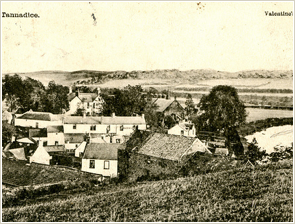
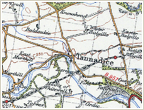
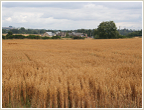
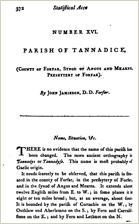
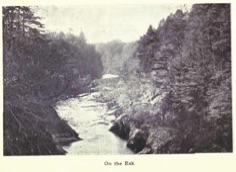
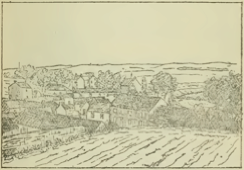
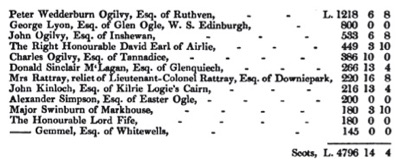
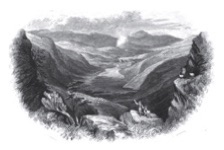
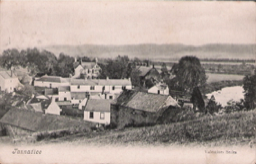
Parochial Registers.—In these no funerals and but few marriages are recorded; and the register of baptisms, which commences in the year 1693, has not always been very regularly kept.
III.—POPULATION.
On a map, engraven about fifty years ago from a survey of the county made by Mr Ainslie, the population of this parish is stated to be 2000. By the census of 1801, the population is nearly 1300. At the former of these periods, there were many small holdings in Glenquiech, and more particularly in Glen Ogle, the dwellings on which have been demolished, their patches of ploughed land and gardens converted into pasture, and the whole let as sheep-farms. From these circumstances the decrease of population may be easily and satisfactorily accounted for. By the census of 1831, the population was 1560. This increase may be accounted for from several feus having been granted, and good houses erected on them, and from a number of new houses having been built by one proprietor, in the village. The spinning and plashmills have also tended to increase the population.
The number of families in the parish is, 294
of families chiefly employed in agriculture, 120
in trade, manufactures, or handicraft, 72
Nine licensed ale and whisky-houses, spinning and plash-mills, bothies, and a heckling-house, contribute nothing to improve the morals of the population. Nevertheless, the people are generally moral in their conduct, and regular in attending public worship.
IV.—INDUSTRY.
Agriculture.—There are 106 holdings of land in the parish direct from the proprietors; but of these more than a half are under forty acres; some of them not exceeding four or five. The remainder are divided into farms, extending from 100 to 400 acres of arable land, the greater part of which are enclosed with dikes of reddish sandstone. The soil is so various that the produce may be calculated at from three to four times as many bolls per Scottish acre.
Rent of Land.—The maximum of rent is about L.3, 10s. per Scottish acre.
Husbandry.—Alternate husbandry is universal. The rotation varies from four to seven years; and small slight two-horse ploughs, some of them of iron, and more of them of wood, are exclusively used. On almost every farm, and indeed on several pendicles, the grain is separated from the straw by mills driven by water or horse. The offices and farm-houses are constructed of stone and lime, and covered with slate, and all of them are comfortable and commodious.
The hills or lower part of the Grampians, comprehending upwards of two-thirds of the surface of the parish, are pastured by about 2400 sheep, which, when lambs, were brought from Linton at nearly double the price which they would have cost four years ago. During the two or three years they are kept, they yield from two to three pounds per fleece of very indifferent wool yearly. The carcases, when fattened on the hill, as they sometimes are, weigh from eight to ten pounds per quarter of well-flavoured mutton. But the far greater part, when rising three or four years old, are sold in October, to be fed off with turnips,—when they increase generally to about fifteen per cent, both in weight and value.
Cattle and Horses.—Many black-cattle are raised, and when rising three years old are stall-fed to the weight of from thirty to sixty stones of excellent beef, much of which is sent to Glasgow or London. The breed of horses is good, and few are used of an inferior description.
Spinning Mills, &c.—There are two spinning, and twice as many plash-mills,—the former of which may each throw off from 1000 or 1400 spindles weekly. No flax produced in this parish is spun at the mills, which are supplied from Dundee and Montrose. Much yarn is brought from the same places to be cleaned, where water and water-power are abundant; and opportunities are not wanting in Forfar and Kirriemuir of converting the yarn into cloth, in which form it is returned to the ports already
mentioned.
V.—PAROCHIAL ECONOMY.
Means of Communication.— Of the great thoroughfare by Dundee to the north, there are about three miles in this parish, viz. from the bridge over the Esk at Finhaven, to that over the Noran at Nether Careston. This piece of turnpike, on which there is a toll-bar, is both nearly straight and level, and is easily kept in excellent order. There are two principal lines in the parish that lead to this turnpike; these, from the great number of very heavy loaded carriages daily, almost hourly, traversing them with coals, grain, flax, yarn, &c. are expensively kept up, and are now in indifferent repair. The other lines of road are numerous and long, and are barely passable in winter. There are four stone bridges over the Esk,—one of them with an arch of 105 feet span, being wholly, and the other three partially, in this parish.
Ecclesiastical State.—The Archbishop of St Andrews had been in use to let the teinds; and the tacksmen levied the ipsa corpora. St Mary's College having become titulars, continued the former practice of uplifting the teind till the year 1718, when the whole annual value of the parish was, upon oath, ascertained to be 15,000 merks Scots, of which a fifth, or 3000 merks, became teind; of this, the College allowed a third to the officiating resident clergyman: of the remaining two-thirds, they were finally relieved, by a decreet of augmentation obtained thirty years ago. Still the living is very inadequate to the charge. The glebe, exclusive of garden, &c. consists of eight Scotch acres, and if valued at the same rate as a few additional acres which the incumbent rents, would be worth L.28 Sterling. The church has had a choir and an oriel window,—indications of a Roman Catholic origin. It is in a tolerable state of repair, but otherwise very inconvenient and uncomfortable. The manse was built in 1797, and has since received an addition, and, as a whole, is substantial, comfortable, and most delightfully situated. The other accommodations are of later erection than the manse, and are spacious and substantial.
The parish church, which is but indifferently seated, may contain 650 persons. The communicants are about 570, besides about 100 who annually communicate at Cortachy; in all, nearly 700. Three of the heritors are of the Episcopalian persuasion, and two are Presbyterians. There are three women and one man who attend the Secession. An Episcopalian minister officiated in the parish church till the year 1716; but, being favourable to the rebellion, he was dismissed, and his son was hanged. The people then elected and got a Presbyterian minister ordained and admitted; but in the course of six years he became so unpopular, and was so grossly slandered, as to be deposed; but upon a review of the sentence, it was found so iniquitous that it was cancelled in a few years; yet the poor man had neither opportunity nor encouragement to exercise his restored privileges, as another had in the meantime been installed in his place. Nor did the latter long enjoy his situation. On his death, St Mary's College wished to fill up the vacancy, but the person they recommended being rejected, another was popularly elected. At next vacancy the patrons exercised their right, and after going more than once the round of all the church courts, made it good. If the three former incumbencies were stormy, this was a hurricane, terminated only by death, the settler of all controversies, and leaving a
large debt for law expenses.
Education.—The parochial schoolmaster has an excellent dwelling-house, and teaching-room apart,—both beautifully situated. His accommodations are good, and his salary the maximum. There are other three male teachers in the parish,—one of whom depends nearly altogether upon school-fees; but besides fees, the other two have teaching-rooms, dwelling-houses, and gardens, free, and not less than L.10 annually, by subscription or otherwise. There are about as many female as male teachers in the parish; of these, one has a beautiful cottage, and well kept garden, some bolls of meal yearly, and a supply of milk daily, all from the generosity of Lady Airly. The reading of English, the various uses of the needle, French, and music, are taught in this female seminary, where boarders are kept. The two first branches only are taught in the other schools, and the mistresses have no sources of support except the fees. About 200 children receive instruction in the elementary and higher branches of education. There are also two Sabbath schools, one of them taught gratuitously by some members of the minister's family, and other well-disposed individuals.
All persons in the parish above seven years of age can read, and there are but very few who have not made some additional literary attainments.
Libraries.—We have two parochial libraries, viz. one in the village, kept by the parochial schoolmaster; the other in Glen Ogle, kept by the schoolmaster in that district. The latter consists principally of moral and religious books and tracts, with a few historical works; the former consists of all these, with not a few fictitious compositions.
Poor and Parochial Funds.—Nearly a century ago, there appears to have been, during several years, a parochial assessment for the support of the poor, which was found to be not only troublesome and expensive, but also demoralizing. There being a small sum, or parochial fund, belonging to the poor, it was raised by donations and collections, until in the year 1796 it amounted to L.210 Sterling. This stock, though reduced by the four very severe seasons of 1799, 1800, 1816, and 1822, amounts at present to L.318 Sterling, bearing four per cent, interest on good security. The interest, with the weekly collections made in the church, mortcloth money, and occasional donations, amounts in all, according to the annual balance-sheets of the three last years, to from L.75 to L.78 annually. This sum is distributed amongst four families and eight individuals, whose allowances range from 2s. 6d. to 10s. monthly; besides house rent, fuel, shoes, &c. But there are many who receive privately donations in money, meal, flannel, &c.— they eking out, by their own industry or the aid of others, what farther is necessary for their support. In this way, they are either not known, or not considered, as paupers.
Savings Bank.—A savings bank, on a sure foundation, has existed twenty years in the parish, in which there are deposited upwards of L.300, greatly to the benefit of both male and female shareholders. The latter always draw out on the certain prospect of marriage; and the former, when any situation of independence casts up. The interest is a comfortable addition to the incomes of many.
Fuel.—Everything capable of ignition is used as fuel, viz. whins, broom, brushwood, turf, peats, and coals; the last can be purchased at Montrose for 1s. 1d., or a little more per barrel, of 10 stones English weight, or 160 pounds. The upper part of the parish, to which coals were almost inaccessible, can now be as easily supplied from the depot at Newtyle by the rail-road, as the lower from Montrose. There are thirteen taxable carriages at present running in the parish, some of them with four, and others with two wheels. Forty years ago there was not one of either description. Few of the roads, indeed, were suitable for such vehicles. Miscellaneous Observations.
The principal improvements within the last forty years have been already mentioned. It may be added, that, if we may judge by the longevity of many, the parish is very healthy. A few years ago seven men and a maiden lady died in one year, all upwards of eighty years of age: and last winter, a man, who had been at the battle of Culloden, died at the age of 104, and another only twelve years younger. There are at present upwards of ten persons alive about eighty years of age; and three nearly ninety.
January 1835.
**********
PARISH OF TANNADICE.
PRESBYTERY OF FORFAR, SYNOD OF ANGUS AND MEARNS.
THE REV. J. BUIST, MINISTER.
I.—TOPOGRAPHY AND NATURAL HISTORY.
Name and Boundaries.—The name of this parish was formerly - spelt Tannadyse; but in more modern times it is spelt Tannadice. Both are obviously resolvable into Taynatas, a Gaelic word, which signifies "a low warm green plat upon the water." A better description could not be given in any number of words, of the low sheltered bottom, situated on the South Esk, on which the church, manse, and kirk-town or village stand. But although peculiarly applicable to these, it is not so to much of the rest of the parish, which is in the form of an obtuse-angled triangle; the side subtending the obtuse angle, which is from 11 to 12 miles long, separating on the E. and N. E. the parish of Tannadice from those of Careston, Fern, and Navar; and the sides which contain the obtuse angle, separating Tannadice on the S. E., S. W. and N. W. from the parishes of Aberlemno, Oathlaw, Kirriemuir, and Cortachy. The boundary lines contain not less than 60 square miles of surface, or 38,400 imperial acres. The longitude of the parish is about two degrees east, and its latitude forty degrees north.
Topographical Appearances.—From the S. E. point of the triangle, the surface of the parish gradually rises in undulating ridges to the foot of the Grampians. Of these, the most elevated is called St Arnold's seat, which is nearly 500 feet higher than the parish church, and not less than 800 above the level of the sea. Nothing of the history of this saint is known, nor is any reason assigned for his resting on this lofty eminence, surmounted by a large cairn. The view from this height extends to the Scottish capital,—having the Pentland and Lammermuir hills in the back ground, with much varied and interesting scenery intervening.
Hydrography.—There are two beautiful streams in the parish, the one called the South Esk, the other, the Noran, on whose banks a showy house and court of offices were lately erected, and from their situation called Noranside. The former of these arises from Loch Esk, in the parish of Clova, about twenty miles above the kirk of Tannadice ; within which parish the latter also arises; and both unite at the south-east angle of the parish. The course and quantity of water of the former are treble that of the latter. Both afford excellent amusement to anglers; but it is only in the Esk that salmon is found, and that in quantities so inconsiderable that no one has appropriated them. Mussels may be found in the Esk; but neither so numerous nor valuable as they are reported to have formerly been, when many of them were annually collected for sake of the pearls of uncommon size which they contained.
Geology.—A dike of whinstone rock runs from east to west the whole breadth of the parish. No other stone appears on the south of this dike; but close to it, and on the north, there lies a reddish coarse sandstone, which is quarried at various places, and fit for different purposes, particularly for building dikes. This stone gradually grows darker in the colour, till it reaches nearly the summit of the lower Grampian ridge, where blue slates are found; but these are small, and considerably warped,—circumstances which, together with the ease and abundance with which gray slates can be got, prevent the blue from being much quarried. This vein appears to be a continuation of that which originates at Johnshaven, in the Mearns, and terminates at Easdale, in Argyleshire, and is advantageously quarried in the neighbourhood of Dunkeld, Newtyle, and other places.
II.—CIVIL HISTORY.
Antiquities.—Three conical tumuli called Laws have in this parish been levelled, and the ground on which they stood cultivated within these few years. In these tumuli, coarse earthen pots or urns were found, protected and surrounded by six flat square stones, and containing a quantity of black ashes, probably the remains of the illustrious dead; while the remains of the less eminent seem to have been deposited in, and covered by the same number of stones, called coffins, but without any urns or ashes, or accumulations of earth. Perhaps the bodies of the former were burned, while those of the latter were not so honoured.
Modern Buildings.—Downiepark is a splendid mansion, and elegantly furnished. It was erected by the late Lieutenant-Colonel Rattray of the Bengal artillery, and is occasionally inhabited by his widow, the liferentrix of this and his other property. This house has, on the north, a near view of the towering summits of the lower Grampain range, covered with native heath, or clothed with thriving larch, lately planted by the Earl of Airlie; and nearer still, the castles of Cortachy and Innerquharity, with their policies of aged wood, the South Esk winding amongst them its dark, troubled, and noisy way to the ocean.—About two miles farther down the stream, stands the house of Inshewan, very lately built by its present worthy occupant, John Ogilvy, Esq. who constantly resides there with his family. On the north of this house is a moor lately planted, which promises soon to become a great ornament, and to afford much shelter.—About four miles still farther down, stands the house of Tannadice, built about thirty years ago by Charles Ogilvy, Esq. who acted about twenty years as a surgeon in the East India Company's Service. It has in front, the Esk, with a bridge over it of three arches, and the castle and hill of Finhaven, and is surrounded by young planting of the proprietor's own raising.—Nearly opposite, and on the other side of the water, is the house of Whitewell, the property of -- Gemmel, Esq. which he inherits from a paternal grandfather. There are also the houses of Easter Ogle and Wester Ogle, and Glenquiech; and on Wester Markhouse, Major Swinburn has just built a handsome dwelling in the style of the English cottage.
Land-owners.—There are, in all, twelve proprietors in the parish,—none of whom draw a rent of less than L.300 Sterling. Their valued rents are as follows:—
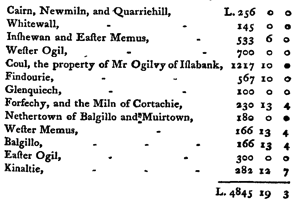
The patronage of this parish belongs to St Mary's College St Andrews. One of the Popes made a grant of the lands of Tannadice, for the erection of this College; but in what year I have not been able to learn. In a seisin, dated anno 1614, they are designed the ecclesiastical lands of Tannadyse. The tithes are all exhausted. The old stipend consisted of one-third of the value of the tithes, amounting to 1000 merks Scotch, with 100 for providing elements. The stipend has been lately augmented to L.100 Sterling, exclusive of the glebe.
The oldest register extant reaches no farther back than to the year 1693. Mr George Lyon, who seems to have been Episcopalian minister here for many years, was allowed to continue till the year 1715; when, on account of the state of public matters, many ministers of this persuasion, who had been formerly suffered to keep possession of the parish churches, and to enjoy the livings, were turned out. He was succeeded by a Presbyterian minister of the name of Oliphant; and he, anno 1724, by Mr John Ogilvie, formerly minister of Cortachie and Clova, Mr John Weath was fixed here, anno 1743; and was succeeded by Mr John Buik, anno 1767. He died in March last. The church is presently vacant. During Mr Weath's incumbency both the church and manse were repaired. The church is supposed to be pretty old; but it is not known when it was built.
Eleven or twelve persons usually receive alms. The contributions for the relief of the poor annually amount to about L. 30. A small fund, which produces L.1 per year, was left, for their benefit, by Mr Ramsay of Kinaltie.
This parish furnishes very little to please the taste of an antiquary. On the north side of Elk, very near the place where the bridge of Shealhill now stands, formerly stood the castle of Quiech, the residence of the Earls of Buchan, who, in ancient times, had an extensive property in this county. The situation is romantic; and was still more adapted for being the seat of a feudal chieftain, by the security which it promised, than by its pleasantness. The castle was built on a precipitous rock, immediately overhanging the river. This rock appears as if insulated by nature. A stream pours down through a deep chasm on each fide of it. Thus it scarcely required any artificial means of defence. No vestiges of this ancient castle are now discernible. A humble cottage occupies its place. Within these few years, part of one of the walls of the chapel was standing. It was neatly built with hewn stones. But they have been lately carried off, and applied some other way.
A hill, in the neighbourhood of Achlouchrie, receives the name of the Castlehill. Like the site of the castle of Quiech, it overhangs the river, which here runs in a deep bed, by reason of the high rocks on either side. A fosse, still twelve feet deep and thirty wide, forms a semicircle round this hill. This, it is supposed, had been dug with a design to bring in water from the river for defending the place. It would seem, however, that there never has been any building here, as there are no marks of foundations.
Near the village of Tannadice, there is a place called the Castle of Barnyards. According to the tradition of the country, a gentleman of the name of Lindsay began to erect a castle here; but having killed the proprietor of Finhaven, in a quarrel, near this place, was obliged to fly. Thus, it is said, the building was never finished. Within these few years, several of the vaults were standing; and some of the walls, from five to seven feet in height. But the stones have been employed for building on the farm. Some centuries ago, great part of this county was in the possession of the Lindsays, whose chief, the Earl of Crawford, had his residence at Findhaven, a little way from this, on the other side of the river. The Lindsays, formerly of Glenquiech, pretended to be the proper heirs of the lands of Barnyards.
There are various Laws in this parish ; as the Law of Balgillo, the Law of Balduckie, the Law of Coul, and several others.
About twenty years ago, a considerable number of coins, both gold and silver, were found at Balgillo. But it is not known to what country, or to what age, they belonged.
